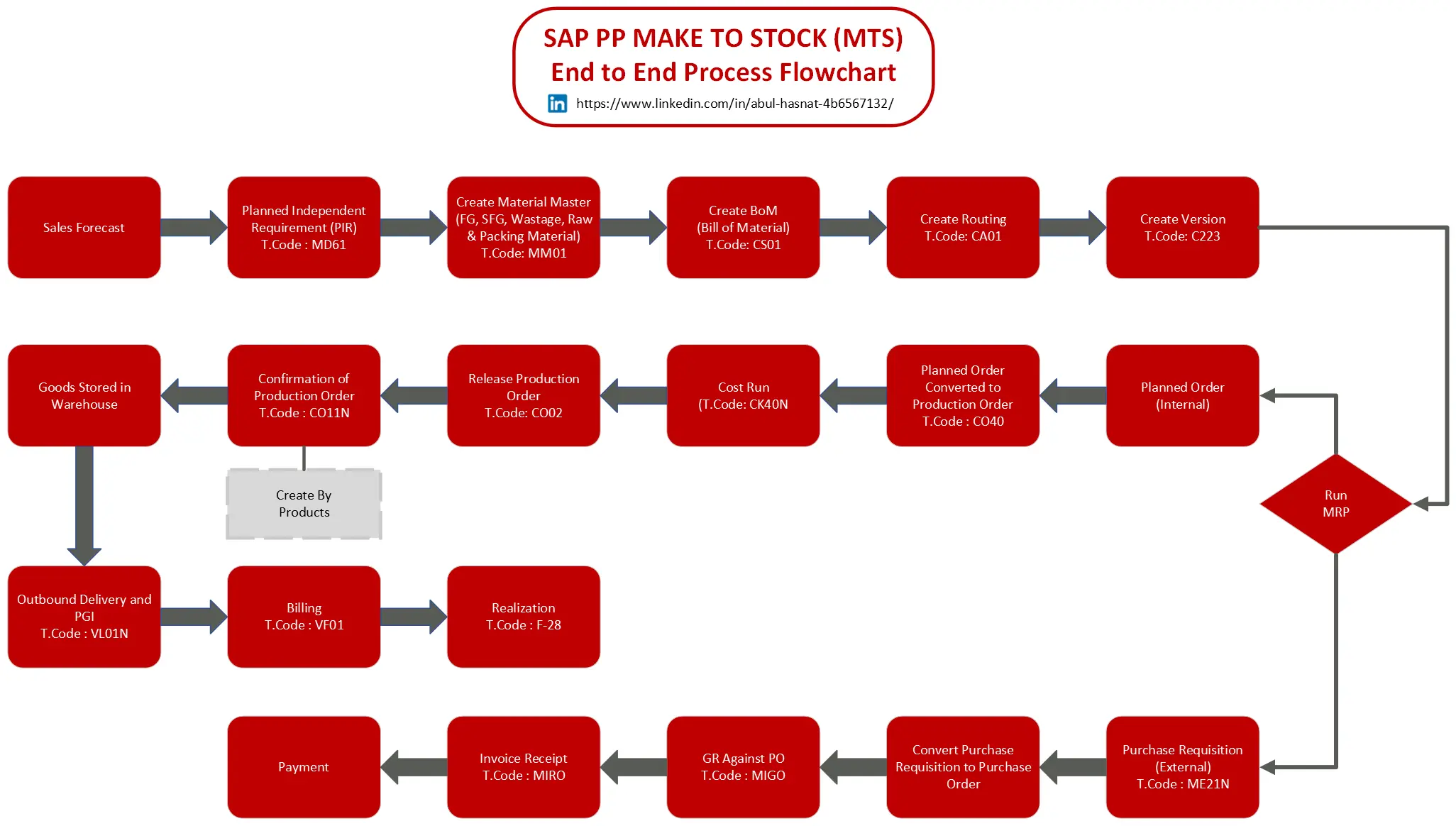This flowchart, prepared by Abul Hasnat, illustrates the end-to-end process for a “Make-to-Stock” (MTS) scenario in SAP Production Planning (PP). An MTS strategy is a production method where finished goods are produced in anticipation of customer demand, and stored in inventory until they are sold.
The flowchart outlines the steps involved in this process, which can be broadly categorized into four phases: Planning, Production Execution, Warehouse Management, and Sales & Distribution.
-
Production Planning
- Sales Forecast: This step involves creating a forecast to predict future customer demand for finished goods. This forecast is used in the Material Requirements Planning (MRP) stage to determine what raw materials need to be ordered and when.
- Planned Independent Requirement (PIR): A Planned Independent Requirement (PIR) is a forecast item in SAP that represents the anticipated demand for a finished good over a certain period. PIRs are created in the Material Master (MM) module of SAP using transaction code MD61.
- Create Material Master: The bill of materials (BOM) and routing information are linked to a material master record in the MM module. The material master record contains all the information about a material, including its physical characteristics, inventory control data, and purchasing information. Transaction code MM01 is used to create a material master record.
- Create BOM: The bill of materials (BOM) is a list of all the raw materials, sub-assemblies, and components that are required to produce a finished good. It specifies the quantity of each item needed and the units of measure. Transaction code CS01 is used to create a BOM in SAP.
- Create Routing: The routing defines the sequence of operations or steps needed to produce a finished good. It also specifies the work centers or machines required for each operation, the standard times allowed for each operation, and any special tools or materials needed. Transaction code CA01 is used to create a routing in SAP.
- Create Version: A version is a snapshot of a routing or BOM at a specific point in time. Versions are used to control changes to routings and BOMs. When a routing or BOM is changed, a new version is created.
- Run MRP: Material Requirements Planning (MRP) is a process used to determine the requirements for raw materials, sub-assemblies, and components needed to produce finished goods. The MRP process takes into account the sales forecast, the BOM , and the routing, as well as current inventory levels and lead times. MRP is typically run periodically in SAP, but it can also be run manually.
-
Production Execution
- Planned Order Converted to Production Order: When MRP is run, it creates planned orders for the materials that are required. A planned order is a preliminary document that is used to represent the demand for a material. Planned orders can be converted into production orders, which are used to authorize the production of a finished good. Transaction code CO01 is used to create a production order in SAP.
- Production Order Release: Before a production order can be started, it must be released. The release process checks to ensure that all of the materials required for the production order are available in inventory. Transaction code CO02 is used to release a production order in SAP.
- Confirmation of Production Order: The confirmation process is used to record the actual production output and to update the inventory levels of the finished goods and raw materials. Transaction code CO11N is used to confirm a production order in SAP.
-
Warehouse Management
- Goods Stored in Warehouse: After the finished goods have been produced, they are transferred to a warehouse for storage. The warehouse management system in SAP keeps track of the quantity and location of all materials in the warehouse.
- Cost Update (T.Code: CK40N): This step may involve updating the cost of the finished goods in the warehouse. There are a number of ways to do this in SAP, such as using a costing variant or a material valuation process.
-
Sales & Distribution
- Outbound Delivery and PGI (T.Code: VL01N): When a customer places a sales order for a finished good, an outbound delivery document is created in the Sales & Distribution (SD) module of SAP. The outbound delivery document is used to pick the finished goods from the warehouse and deliver them to the customer. The picking process is confirmed by a goods issue (GI) document.
- Billing (T.Code: VF01): After the finished goods have been delivered to the customer, a billing document is created in the SD module to invoice the
